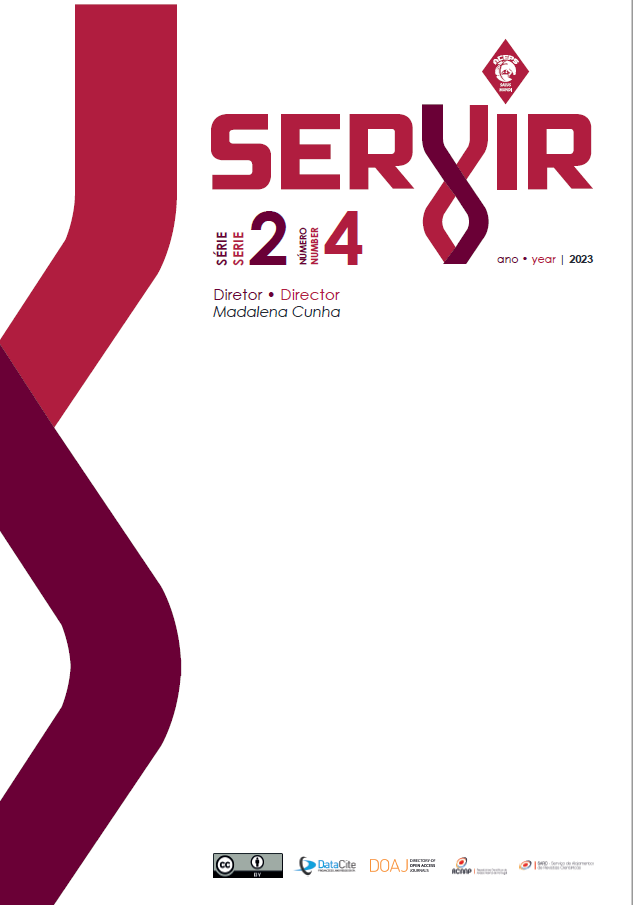Intercurrences in the inter-hospital transport of the person in critical situation
DOI:
https://doi.org/10.48492/servir0204.28388Keywords:
complications, critical care, patient transportAbstract
Introduction: The inter-hospital transport of the person in critical condition is a frequent procedure and represents an additional risk for the patient.
Objective/s: Describe the intercurrences in the inter-hospital transport of the person in critical situation.
Methods: Retrospective descriptive cross-sectional study. The study included 48 patients from the General Emergency Service of a Hospital Center in the northern region of Portugal, subject to inter-hospital transport, by land, between July 2020 and March 2021. Data collection was performed using the inter-hospital transport record sheet and provided, anonymously, by the service director, after appearing in favor of the ethics committee.
Results: The sample is mostly composed of male (60.4%), with a mean age of 66.75±20.26 years and an average transport time of 64.11±08.18 minutes. The most frequent specialty of origin was neurology (60.4%). There were 79.2% of intercurrences. 80.9% were clinical and the most frequent was blood pressure ≥ 140 mmHg (47.9%). Of the non-clinical intercurrences (19.1%), the most frequent was the externalization of the peripheral venous catheter (16.7%).
Conclusion: There was a higher frequency of clinical intercurrences, in males, with a higher percentage in the age group between 75-84 years. Non-clinical ones were more frequent in the age group aged ≥85 years. We suggest more frequent or even invasive monitoring of vital
parameters for timely control and treatment of hypertensive peaks and greater vigilance regarding the fixation peripheral venous catheter.
Downloads
References
Bérubé, M., Bernard, F., Marion, H., Parent, J., Thibault, M., Williamson, D. R., & Albert, M. (2013). Impact of a preventive programme on the occurrence of incidents during the transport of critically ill patients. Intensive & critical care nursing, 29(1), 9–19. https://doi.org/10.1016/j.iccn.2012.07.001
Brunsveld-Reinders, A. H., Arbous, M. S., Kuiper, S. G., & de Jonge, E. (2015). A comprehensive method to develop a checklist to increase safety of intra-hospital transport of critically ill patients. Critical care (London, England), 19(1), 214. https://doi.org/10.1186/s13054-015-0938-1
Droogh, J. M., Smit, M., Absalom, A. R., Ligtenberg, J. J., & Zijlstra, J. G. (2015). Transferring the critically ill patient: are we there yet?. Critical care (London, England), 19(1), 62. https://doi.org/10.1186/s13054-015-0749-4
Graça, A., Silva, N. A. P., Correia, T. I. G., Martins (2017). Transporte inter-hospitalar do doente crítico: a realidade de um hospital do nordeste de Portugal. Revista de Enfermagem Referência. Série IV(15): 133 – 144. https://doi.org/10.12707/RIV17042
Graça, A., Silva, N., Correia, T. (2019). Transporte inter-hospitalar do doente crítico: A realidade de um hospital do Nordeste de Portugal. Novas edições Acadêmicas.
Instituto Nacional de Emergência Medica –INEM (2012) – Transporte do Doente Crítico. 1ª edição.
Intensive Care Society. (2019). Guidance on: The Transfer of The Critically ill Adult. The Faculty os Intensive Care Medicine, 1-40. https://www.ficm.ac.uk/sites/ficm/files/documents/2021-10/Transfer_of_Critically_Ill_Adult.pdf
Lovell, M. A., Mudaliar, M. Y., & Klineberg, P. L. (2001). Intrahospital transport of critically ill patients: complications and difficulties. Anaesthesia and intensive care, 29(4), 400–405. https://doi.org/10.1177/0310057X0102900412
Mata, E. S. F. (2014). Dificuldades do enfermeiro no transporte secundário do doente crítico. Dissertação de Mestrado, Escola Superior de Saúde - Instituto Politécnico de Leiria, Portugal. https://iconline.ipleiria.pt/bitstream/10400.8/2264/1/Disserta%c3%a7%c3%a3o%20Ema%20Mata.pdf
Mohr, N. M., Wong, T. S., Faine, B., Schlichting, A., Noack, J., & Ahmed, A. (2016). Discordance Between Patient and Clinician Experiences and Priorities in Rural Interhospital Transfer: A Mixed Methods Study. The Journal of rural health : official journal of the American Rural Health Association and the National Rural Health Care Association, 32(1), 25–34. https://doi.org/10.1111/jrh.12125
Regulamento n.º 429/2018, de 16 de julho. Regulamento de competências específicas do enfermeiro especialista em enfermagem médico-cirúrgica na área de enfermagem à pessoa em situação crítica, na área de enfermagem à pessoa em situação paliativa, na área de enfermagem à pessoa em situação perioperatória e na área de enfermagem à pessoa em situação crónica. Diário da República, 135. Série II, Ordem dos Enfermeiros, (2018). https://files.dre.pt/2s/2018/07/135000000/1935919370.pdf
Sociedade Portuguesa de Cuidados Intensivos & Ordem dos Médicos (Comissão da competência em Emergência Médica) (2008). Transporte do Doente Crítico- Recomendações. https://www.spci.pt/media/documentos/15827260365e567b9411425.pdf
Waydhas C. (1999). Intrahospital transport of critically ill patients. Critical care (London, England), 3(5), R83–R89. https://doi.org/10.1186/cc362
Wiegersma, J. S., Droogh, J. M., Zijlstra, J. G., Fokkema, J., & Ligtenberg, J. J. (2011). Quality of interhospital transport of the critically ill: impact of a Mobile Intensive Care Unit with a specialized retrieval team. Critical care (London, England), 15(1), R75. https://doi.org/10.1186/cc10064
Zuchelo, L. T., & Chiavone, P. A. (2009). Intrahospital transport of patients on invasive ventilation: cardiorespiratory repercussions and adverse events. Jornal brasileiro de pneumologia : publicacao oficial da Sociedade Brasileira de Pneumologia e Tisilogia, 35(4), 367–374. https://doi.org/10.1590/s1806-37132009000400011
Published
How to Cite
Issue
Section
License
Copyright (c) 2023 Servir

This work is licensed under a Creative Commons Attribution 4.0 International License.
In order to promote the free circulation of knowledge, Servir is open access journal. All its content is available and protected under the Creative Commons license (CC BY 4.0).
The journal allows self-archiving in institutional repositories of all versions, which may become immediately available


